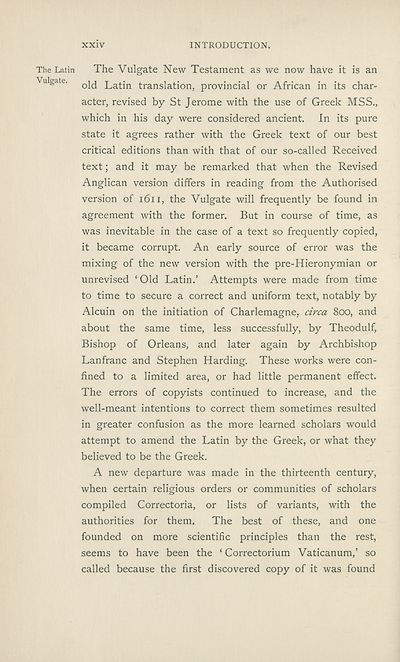Download files
Complete book:
Individual page:
Thumbnail gallery: Grid view | List view

XXIV
INTRODUCTION.
The Latin
Vulgate.
The Vulgate New Testament as we now have it is an
old Latin translation, provincial or African in its char¬
acter, revised by St Jerome with the use of Greek MSS.,
which in his day were considered ancient. In its pure
state it agrees rather with the Greek text of our best
critical editions than with that of our so-called Received
text; and it may be remarked that when the Revised
Anglican version differs in reading from the Authorised
version of 1611, the Vulgate will frequently be found in
agreement with the former. But in course of time, as
was inevitable in the case of a text so frequently copied,
it became corrupt. An early source of error was the
mixing of the new version with the pre-Hieronymian or
unrevised ‘ Old Latin.’ Attempts were made from time
to time to secure a correct and uniform text, notably by
Alcuin on the initiation of Charlemagne, circa 800, and
about the same time, less successfully, by Theodulf,
Bishop of Orleans, and later again by Archbishop
Lanfranc and Stephen Harding. These works were con¬
fined to a limited area, or had little permanent effect.
The errors of copyists continued to increase, and the
well-meant intentions to correct them sometimes resulted
in greater confusion as the more learned scholars would
attempt to amend the Latin by the Greek, or what they
believed to be the Greek.
A new departure was made in the thirteenth century,
when certain religious orders or communities of scholars
compiled Correctoria, or lists of variants, with the
authorities for them. The best of these, and one
founded on more scientific principles than the rest,
seems to have been the ‘ Correctorium Vaticanum,’ so
called because the first discovered copy of it was found
INTRODUCTION.
The Latin
Vulgate.
The Vulgate New Testament as we now have it is an
old Latin translation, provincial or African in its char¬
acter, revised by St Jerome with the use of Greek MSS.,
which in his day were considered ancient. In its pure
state it agrees rather with the Greek text of our best
critical editions than with that of our so-called Received
text; and it may be remarked that when the Revised
Anglican version differs in reading from the Authorised
version of 1611, the Vulgate will frequently be found in
agreement with the former. But in course of time, as
was inevitable in the case of a text so frequently copied,
it became corrupt. An early source of error was the
mixing of the new version with the pre-Hieronymian or
unrevised ‘ Old Latin.’ Attempts were made from time
to time to secure a correct and uniform text, notably by
Alcuin on the initiation of Charlemagne, circa 800, and
about the same time, less successfully, by Theodulf,
Bishop of Orleans, and later again by Archbishop
Lanfranc and Stephen Harding. These works were con¬
fined to a limited area, or had little permanent effect.
The errors of copyists continued to increase, and the
well-meant intentions to correct them sometimes resulted
in greater confusion as the more learned scholars would
attempt to amend the Latin by the Greek, or what they
believed to be the Greek.
A new departure was made in the thirteenth century,
when certain religious orders or communities of scholars
compiled Correctoria, or lists of variants, with the
authorities for them. The best of these, and one
founded on more scientific principles than the rest,
seems to have been the ‘ Correctorium Vaticanum,’ so
called because the first discovered copy of it was found
Set display mode to: Large image | Zoom image | Transcription
Images and transcriptions on this page, including medium image downloads, may be used under the Creative Commons Attribution 4.0 International Licence unless otherwise stated. ![]()
| Publications by Scottish clubs > Scottish Text Society publications > Old series > New Testament in Scots > Volume 1, 1901 > (33) |
|---|
| Permanent URL | https://digital.nls.uk/107720729 |
|---|
| Description | Volume 1. Introduction, Prologe, Matthewe-Luke. |
|---|---|
| Attribution and copyright: |
|
| Description | A collection of over 100 Scottish texts dating from around 1400 to 1700. Most titles are in Scots, and include editions of poetry, drama, and prose by major Scottish writers such as John Barbour, William Dunbar, Gavin Douglas, and George Buchanan. Edited by a key scholarly publisher of Scotland's literary history, and published from the late 19th century onwards by the Scottish Text Society. Available here are STS series 1-3. |
|---|

